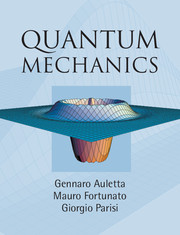Book contents
- Frontmatter
- Contents
- List of figures
- List of tables
- List of definitions, principles, etc.
- List of boxes
- List of symbols
- List of abbreviations
- Introduction
- Part I Basic features of quantum mechanics
- 1 From classical mechanics to quantum mechanics
- 2 Quantum observables and states
- 3 Quantum dynamics
- 4 Examples of quantum dynamics
- 5 Density matrix
- Part II More advanced topics
- Part III Matter and light
- Part IV Quantum information: state and correlations
- Bibliography
- Author index
- Subject index
1 - From classical mechanics to quantum mechanics
Published online by Cambridge University Press: 05 June 2012
- Frontmatter
- Contents
- List of figures
- List of tables
- List of definitions, principles, etc.
- List of boxes
- List of symbols
- List of abbreviations
- Introduction
- Part I Basic features of quantum mechanics
- 1 From classical mechanics to quantum mechanics
- 2 Quantum observables and states
- 3 Quantum dynamics
- 4 Examples of quantum dynamics
- 5 Density matrix
- Part II More advanced topics
- Part III Matter and light
- Part IV Quantum information: state and correlations
- Bibliography
- Author index
- Subject index
Summary
In this chapter we shall first summarize some conceptual and formal features of classical mechanics (Sec. 1.1). Modern physics started with the works of Galileo Galilei and Isaac Newton from which classical mechanics, one of the most beautiful and solid intellectual buildings of the human history, came out. The architecture of classical mechanics was developed between the end of the eighteenth century and the second half of the nineteenth century, and its present form is largely due to Lagrange, Jacobi, and Hamilton. As we shall see in this chapter, classical mechanics is built upon the requirement of determinism, a rather complex assumption which is far from being obvious. In Sec. 1.2 we shall present the two main conceptual features of quantum mechanics on the basis of an ideal interferometry experiment: the superposition principle and the principle of complementarity. In Sec. 1.3 a first formal treatment of quantum-mechanical states is developed: quantum states are represented by vectors in a space that turns out to be a Hilbert space. In Sec. 1.4 the significance of probability for quantum mechanics is explained briefly: we will show that probability is not just an ingredient of quantum mechanics, but is rather an intrinsic feature of the theory. Furthermore, we shall see that quantum probability is not ruled by Kolmogorov axioms of classical probability. Finally, we discuss the main evidences which have historically revealed the necessity of a departure from classical mechanics.
- Type
- Chapter
- Information
- Quantum Mechanics , pp. 7 - 42Publisher: Cambridge University PressPrint publication year: 2009



